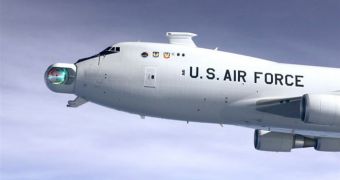A new airborne defense system using lasers has recently misfired in a new battery of tests, when a glitch in its software made it miss a missile it was targeting.
The goal of the flying laser is to provide the United States with a new method of defending against incoming missile. This is achieved by blasting the objects with intense pulses of laser light.
Previous tests have demonstrated that this is achievable, but now experts are working hard on getting the project completed. The recent demonstration was the latest in ht project.
The air born laser is currently being constructed for the US Missile Defense Agency (MDA), which ordered it precisely to boost its abilities.
In its first tests, the Boeing 747-mounted flying laser laboratory was able to hit a target in mid-flight, and mission managers had hoped to replicate that success in this round of testing as well.
But the laser was deprived of precision aiming, when a software glitch prohibited it from locking on the target missile, and destroying it, Space reports.
The flight test took place on September 1 in southern California, at the Point Mugu flight test range. A liquid-fuel, short-range ballistic missile was used as a target for the airborne laser.
Though the rocket was correctly found, identified, and then tracked down, an error prompted safeguards aboard the plane to shut down the high-energy laser that is used for attacks.
“The laser terminated before the short-range threat representative target was destroyed,” MDS spokeswoman Debra Christman told Space on September 17.
She went on to say that many factors are involved in determining the most appropriate time to attack a target. These factors include distance to the rocket, the type of missile used, and also the weather.
In a series of tests the airborne laser system conducted this February, it was revealed that it can easily destroy a sounding rocket in mid-flight. The new assessments sought to do the same from twice the distance.
The Boeing airplane carries a turret on its nose, where the weapons is located. Next to the main, megawatt-class laser that can destroy rockets are two kilowatt-class ones, which are used for tracking.
An adaptive optics system is also used on board, so that the computers which calculate the firing trajectory can account for disturbances in the field of view, which may be produced by atmospheric events.

 14 DAY TRIAL //
14 DAY TRIAL //